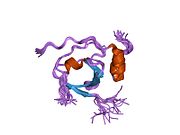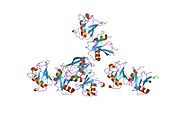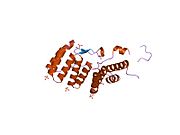Neutrophil cytosolic factor 2
| NCF2 | |||||||||||||||||||||||||||||||||||||||||||||||||||
|---|---|---|---|---|---|---|---|---|---|---|---|---|---|---|---|---|---|---|---|---|---|---|---|---|---|---|---|---|---|---|---|---|---|---|---|---|---|---|---|---|---|---|---|---|---|---|---|---|---|---|---|
 | |||||||||||||||||||||||||||||||||||||||||||||||||||
| |||||||||||||||||||||||||||||||||||||||||||||||||||
| Identifiers | |||||||||||||||||||||||||||||||||||||||||||||||||||
| Aliases | NCF2, NCF-2, NOXA2, P67-PHOX, P67PHOX, Neutrophil cytosolic factor 2 | ||||||||||||||||||||||||||||||||||||||||||||||||||
| External IDs | OMIM: 608515; MGI: 97284; HomoloGene: 374; GeneCards: NCF2; OMA:NCF2 - orthologs | ||||||||||||||||||||||||||||||||||||||||||||||||||
| |||||||||||||||||||||||||||||||||||||||||||||||||||
| |||||||||||||||||||||||||||||||||||||||||||||||||||
| |||||||||||||||||||||||||||||||||||||||||||||||||||
| |||||||||||||||||||||||||||||||||||||||||||||||||||
| |||||||||||||||||||||||||||||||||||||||||||||||||||
| Wikidata | |||||||||||||||||||||||||||||||||||||||||||||||||||
| |||||||||||||||||||||||||||||||||||||||||||||||||||
Neutrophil cytosol factor 2 is a protein that in humans is encoded by the NCF2 gene.
Function
This gene encodes neutrophil cytosolic factor 2, the 67-kilodalton cytosolic subunit of the multi-protein complex known as NADPH oxidase found in neutrophils. This oxidase produces a burst of superoxide which is delivered to the lumen of the neutrophil phagosome. Mutations in this gene, as well as in other NADPH oxidase subunits, can result in chronic granulomatous disease.[5]
References
- ^ a b c GRCh38: Ensembl release 89: ENSG00000116701 – Ensembl, May 2017
- ^ a b c GRCm38: Ensembl release 89: ENSMUSG00000026480 – Ensembl, May 2017
- ^ "Human PubMed Reference:". National Center for Biotechnology Information, U.S. National Library of Medicine.
- ^ "Mouse PubMed Reference:". National Center for Biotechnology Information, U.S. National Library of Medicine.
- ^ "Entrez Gene: NCF2 neutrophil cytosolic factor 2 (65kDa, chronic granulomatous disease, autosomal 2)".
Further reading
- Wientjes FB, Segal AW (December 1995). "NADPH oxidase and the respiratory burst". Seminars in Cell Biology. 6 (6): 357–65. doi:10.1016/S1043-4682(05)80006-6. PMID 8748143.
- DeLeo FR, Quinn MT (December 1996). "Assembly of the phagocyte NADPH oxidase: molecular interaction of oxidase proteins". Journal of Leukocyte Biology. 60 (6): 677–91. doi:10.1002/jlb.60.6.677. PMID 8975869. S2CID 17946755.
- Dorseuil O, Gacon G (1997). "[Signal transduction by Rac small G proteins in phagocytes]". Comptes Rendus des Séances de la Société de Biologie et de ses Filiales. 191 (2): 237–46. PMID 9255350.
- Leto TL, Lomax KJ, Volpp BD, Nunoi H, Sechler JM, Nauseef WM, Clark RA, Gallin JI, Malech HL (May 1990). "Cloning of a 67-kD neutrophil oxidase factor with similarity to a noncatalytic region of p60c-src". Science. 248 (4956): 727–30. Bibcode:1990Sci...248..727L. doi:10.1126/science.1692159. PMID 1692159.
- Kenney RT, Leto TL (December 1990). "A HindIII polymorphism in the human NCF2 gene". Nucleic Acids Research. 18 (23): 7193. doi:10.1093/nar/18.23.7193-a. PMC 332837. PMID 1979859.
- Francke U, Hsieh CL, Foellmer BE, Lomax KJ, Malech HL, Leto TL (September 1990). "Genes for two autosomal recessive forms of chronic granulomatous disease assigned to 1q25 (NCF2) and 7q11.23 (NCF1)". American Journal of Human Genetics. 47 (3): 483–92. PMC 1683885. PMID 2393022.
- Kenney RT, Malech HL, Epstein ND, Roberts RL, Leto TL (December 1993). "Characterization of the p67phox gene: genomic organization and restriction fragment length polymorphism analysis for prenatal diagnosis in chronic granulomatous disease". Blood. 82 (12): 3739–44. doi:10.1182/blood.V82.12.3739.3739. PMID 7903171.
- Leto TL, Adams AG, de Mendez I (October 1994). "Assembly of the phagocyte NADPH oxidase: binding of Src homology 3 domains to proline-rich targets". Proceedings of the National Academy of Sciences of the United States of America. 91 (22): 10650–4. Bibcode:1994PNAS...9110650L. doi:10.1073/pnas.91.22.10650. PMC 45079. PMID 7938008.
- Dusi S, Rossi F (December 1993). "Activation of NADPH oxidase of human neutrophils involves the phosphorylation and the translocation of cytosolic p67phox". The Biochemical Journal. 296 ( Pt 2) (2): 367–71. doi:10.1042/bj2960367. PMC 1137705. PMID 8257426.
- de Boer M, Hilarius-Stokman PM, Hossle JP, Verhoeven AJ, Graf N, Kenney RT, Seger R, Roos D (January 1994). "Autosomal recessive chronic granulomatous disease with absence of the 67-kD cytosolic NADPH oxidase component: identification of mutation and detection of carriers". Blood. 83 (2): 531–6. doi:10.1182/blood.V83.2.531.531. PMID 8286749.
- Bonaldo MF, Lennon G, Soares MB (September 1996). "Normalization and subtraction: two approaches to facilitate gene discovery". Genome Research. 6 (9): 791–806. doi:10.1101/gr.6.9.791. PMID 8889548.
- Bonizzato A, Russo MP, Donini M, Dusi S (February 1997). "Identification of a double mutation (D160V-K161E) in the p67phox gene of a chronic granulomatous disease patient". Biochemical and Biophysical Research Communications. 231 (3): 861–3. doi:10.1006/bbrc.1997.6204. PMID 9070911.
- Sathyamoorthy M, de Mendez I, Adams AG, Leto TL (April 1997). "p40(phox) down-regulates NADPH oxidase activity through interactions with its SH3 domain". The Journal of Biological Chemistry. 272 (14): 9141–6. doi:10.1074/jbc.272.14.9141. PMID 9083043.
- Ahmed S, Prigmore E, Govind S, Veryard C, Kozma R, Wientjes FB, Segal AW, Lim L (June 1998). "Cryptic Rac-binding and p21(Cdc42Hs/Rac)-activated kinase phosphorylation sites of NADPH oxidase component p67(phox)". The Journal of Biological Chemistry. 273 (25): 15693–701. doi:10.1074/jbc.273.25.15693. PMID 9624165.
- Faris SL, Rinckel LA, Huang J, Hong YR, Kleinberg ME (June 1998). "Phagocyte NADPH oxidase p67-phox possesses a novel carboxylterminal binding site for the GTPases Rac2 and Cdc42". Biochemical and Biophysical Research Communications. 247 (2): 271–6. doi:10.1006/bbrc.1998.8775. PMID 9642115.
- Rinckel LA, Faris SL, Hitt ND, Kleinberg ME (September 1999). "Rac1 disrupts p67phox/p40phox binding: a novel role for Rac in NADPH oxidase activation". Biochemical and Biophysical Research Communications. 263 (1): 118–22. doi:10.1006/bbrc.1999.1334. PMID 10486263.
- Patiño PJ, Rae J, Noack D, Erickson R, Ding J, de Olarte DG, Curnutte JT (October 1999). "Molecular characterization of autosomal recessive chronic granulomatous disease caused by a defect of the nicotinamide adenine dinucleotide phosphate (reduced form) oxidase component p67-phox". Blood. 94 (7): 2505–14. doi:10.1182/blood.V94.7.2505.419k10_2505_2514. PMID 10498624.
External links
- Overview of all the structural information available in the PDB for UniProt: P19878 (Neutrophil cytosol factor 2) at the PDBe-KB.
- v
- t
- e
-
 1e96: STRUCTURE OF THE RAC/P67PHOX COMPLEX
1e96: STRUCTURE OF THE RAC/P67PHOX COMPLEX -
 1hh8: THE ACTIVE N-TERMINAL REGION OF P67PHOX: STRUCTURE AT 1.8 ANGSTROM RESOLUTION AND BIOCHEMICAL CHARACTERIZATIONS OF THE A128V MUTANT IMPLICATED IN CHRONIC GRANULOMATOUS DISEASE
1hh8: THE ACTIVE N-TERMINAL REGION OF P67PHOX: STRUCTURE AT 1.8 ANGSTROM RESOLUTION AND BIOCHEMICAL CHARACTERIZATIONS OF THE A128V MUTANT IMPLICATED IN CHRONIC GRANULOMATOUS DISEASE -
 1k4u: Solution structure of the C-terminal SH3 domain of p67phox complexed with the C-terminal tail region of p47phox
1k4u: Solution structure of the C-terminal SH3 domain of p67phox complexed with the C-terminal tail region of p47phox -
 1oey: HETERODIMER OF P40PHOX AND P67PHOX PB1 DOMAINS FROM HUMAN NADPH OXIDASE
1oey: HETERODIMER OF P40PHOX AND P67PHOX PB1 DOMAINS FROM HUMAN NADPH OXIDASE -
 1wm5: Crystal structure of the N-terminal TPR domain (1-203) of p67phox
1wm5: Crystal structure of the N-terminal TPR domain (1-203) of p67phox -
 2dmo: Refined solution structure of the 1st SH3 domain from human Neutrophil cytosol factor 2 (NCF-2)
2dmo: Refined solution structure of the 1st SH3 domain from human Neutrophil cytosol factor 2 (NCF-2)
 | This article on a gene on human chromosome 1 is a stub. You can help Wikipedia by expanding it. |
- v
- t
- e






















